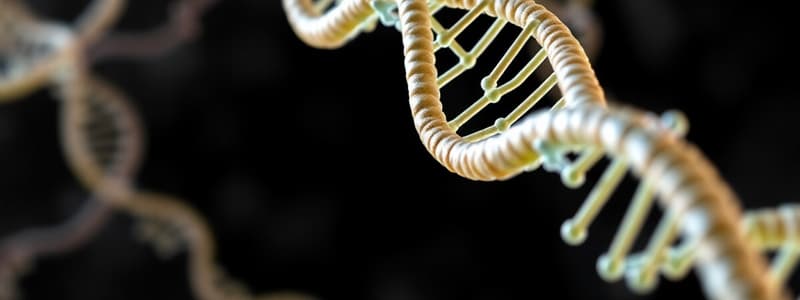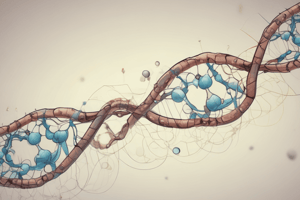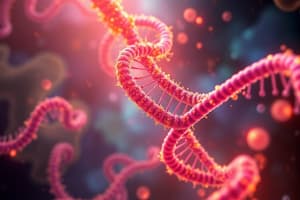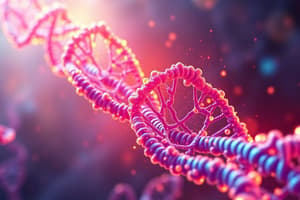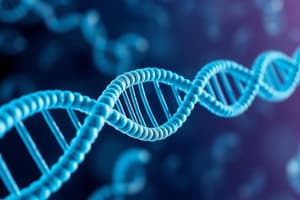Podcast
Questions and Answers
Where does replication take place?
Where does replication take place?
nucleus
What sugar is found in DNA?
What sugar is found in DNA?
- Deoxyribose (correct)
- Ribose
- Fructose
- Glucose
What is the function of RNA polymerase?
What is the function of RNA polymerase?
- To replicate DNA
- To synthesize RNA (correct)
- To form ribosomes
- To translate proteins
Translation occurs in the nucleus.
Translation occurs in the nucleus.
What does a codon consist of?
What does a codon consist of?
A(n) __________ is a change in an organism's DNA.
A(n) __________ is a change in an organism's DNA.
What indicates where translation is to stop?
What indicates where translation is to stop?
What are the building blocks of proteins?
What are the building blocks of proteins?
Mutagen refers to environmental agents that can change DNA.
Mutagen refers to environmental agents that can change DNA.
Match the following RNA types with their functions:
Match the following RNA types with their functions:
What would be the amino acid sequence from the DNA sequence TAC TAT ACC GGT ACT?
What would be the amino acid sequence from the DNA sequence TAC TAT ACC GGT ACT?
A(n) __________ mutation results from the deletion of a nucleotide.
A(n) __________ mutation results from the deletion of a nucleotide.
What is a common reason for point mutations not causing problems?
What is a common reason for point mutations not causing problems?
Flashcards
Replication
Replication
The process of copying DNA.
Transcription
Transcription
The process of making RNA from DNA.
Translation
Translation
The process of making protein from RNA.
DNA
DNA
Signup and view all the flashcards
RNA
RNA
Signup and view all the flashcards
RNA Polymerase
RNA Polymerase
Signup and view all the flashcards
tRNA
tRNA
Signup and view all the flashcards
mRNA
mRNA
Signup and view all the flashcards
Codon
Codon
Signup and view all the flashcards
Mutation
Mutation
Signup and view all the flashcards
Point Mutation
Point Mutation
Signup and view all the flashcards
Frameshift Mutation
Frameshift Mutation
Signup and view all the flashcards
Mutagens
Mutagens
Signup and view all the flashcards
Study Notes
Transcription and Translation
- Replication, Transcription, and Translation occur in eukaryotic cells.
- Replication takes place in the nucleus.
- Transcription takes place in the nucleus.
- Translation takes place in the cytoplasm.
- DNA and RNA have distinct structures.
- DNA contains deoxyribose sugar.
- RNA contains ribose sugar.
- DNA bases are A, C, G, and T.
- RNA bases are A, C, G, and U.
- DNA is double-stranded.
- RNA is single-stranded.
- RNA Polymerase is the enzyme responsible for synthesizing RNA.
- A Transcription Complex assembles at the start of a gene, unwinding the DNA.
- RNA Polymerase uses one strand of DNA as a template to build a complementary strand of RNA.
- The RNA strand detaches from the DNA as it's transcribed, and the DNA zips back together.
- tRNA delivers amino acids to the ribosome.
- rRNA forms part of the ribosome structure.
- mRNA carries the genetic code from DNA to the ribosome.
- The large subunit of a ribosome binds to mRNA and holds tRNA molecules.
- Each tRNA molecule has an anticodon that binds to a complementary codon on mRNA and an amino acid attached to the other end.
- Translation occurs in three main steps:
- The ribosome moves along the mRNA strand, exposing a new codon.
- The ribosome forms a peptide bond between the amino acids, breaking the bond between the first amino acid and its tRNA.
- A complementary tRNA with an amino acid binds to the exposed codon.
- Translation converts an mRNA message into a polypeptide.
- A codon is a sequence of three nucleotides that code for a specific amino acid.
- A reading frame defines the order in which nucleotides are read.
- Codons like AGG, GCA, and GUU are examples of three-nucleotide sequences.
- An anticodon on a tRNA molecule is complementary to an mRNA codon.
- A stop codon signals the termination of translation.
Mutations
- A mutation is a change in an organism's DNA.
- DNA Polymerase cannot catch and correct every replication error.
- A mutagen is an environmental agent that can alter DNA.
- UV light damages DNA by causing thymine nucleotides to bond with each other instead of adenine.
- A frameshift mutation occurs when a nucleotide is deleted from DNA.
Examples
- Amino Acid Sequence: Given the DNA sequence TAC TAT ACC GGT ACT, the resulting amino acid sequence would be Methionine-Isoleucine-Tryptophan-Proline-STOP.
- Point Mutations: Point mutations may not always cause problems for the organism because:
- Multiple codons can code for the same amino acid.
- Silent mutations can change a codon without altering the amino acid it codes for.
- Mutations in non-coding regions or non-critical protein segments may not affect function.
Studying That Suits You
Use AI to generate personalized quizzes and flashcards to suit your learning preferences.
